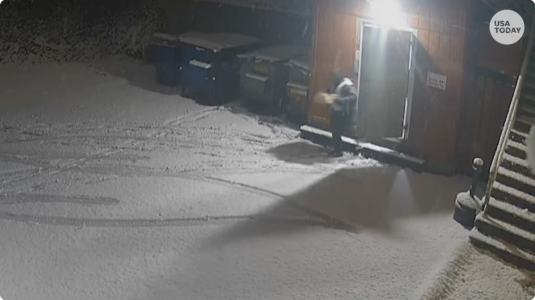Experts reveal their top secrets to keeping your family cozy and safe this winter–don’t miss out!
- Replies 0
As the air turns colder and we switch into our warmer clothes, we're reminded that winter's embrace is just around the corner. For many of us, this season conjures images of cozy firesides and hot cocoa, but it also brings its share of challenges.
From icy roads to the silent threat of frostbite, winter demands respect and preparation. Safety is paramount, especially for our seasoned readers who may face greater risks during the colder months. Here’s you and your loved ones remain snug and secure all winter long.
Snow, ice, and extremely cold temperatures lie ahead, alongside strong winds. To avoid risks like frostbite and hypothermia, as well as power outages and dangerous driving conditions, Catie Ballenger, spokesperson of the American Red Cross says, “The biggest thing is to be prepared.”
Before we delve into the tips, let's take a peek at what Mother Nature might have in store. The National Oceanic and Atmospheric Administration (NOAA) hints at a warmer, drier winter down south, with the northern states bracing for wetter conditions.
Yet, as we've learned, winter weather is a fickle friend, with blizzards from the Mountain West, ice storms in the mid-Atlantic states, and downpours of rain in California ready to surprise us. Power lines and tree branches can also be downtrodden due to heavy, wet snow from the East Coast.

And with climate change stirring the pot, even traditionally milder regions can face severe winter trials, as Texas did in 2021. Over 240 people lost their lives due to the terrible winter storm.
When winter hits, the risks of frostbite and hypothermia climb. These conditions don't just affect the adventurous souls braving the elements; they can catch anyone off guard.
Frostbite can creep in with numbness and pain in your extremities, while hypothermia may disguise itself as fatigue or confusion. The key is to recognize the signs early and act fast—warm up gradually and seek medical attention if symptoms persist.
According to Mike Muccili, acting winter program manager at NOAA, “When people think of frostbite, they think of a change in skin color, but they need to be looking for numbness and pain in the extremities, like the fingers, toes, nose, ears and cheeks.”
Dressing for winter is an art.
The American Red Cross suggests layering—a long-sleeved shirt, a sweater, and a coat, complemented by warm boots, a hat, gloves, and a scarf. This isn't just about comfort; it's about creating a personal insulation system that can adapt to changing conditions. “This keeps things more regulated,” as per Ballenger.
Power outages are the uninvited guests of winter storms, often overstaying their welcome.
To keep your castle warm, experts recommend a home emergency kit stocked with essentials like medications, nonperishable food, water, and a NOAA weather radio.

If the power winks out, insulate your home by drawing curtains and sealing drafts. Gather in a central room to conserve and share heat—but never resort to dangerous heating methods like ovens or outdoor fires, which pose risks of carbon monoxide poisoning and house fires.
Driving in winter is akin to navigating an obstacle course on ice skates. If you must venture out, consider snow tires or chains for better traction.
But the best advice is to avoid driving in severe conditions altogether. More than 1,300 people have succumbed to death due to car accidents while the roads are snowy and icy, according to the US Department of Transportation.
If travel is unavoidable, pack your vehicle with a winter survival kit: blankets, extra clothing, flashlights, snacks, water, and tools for snow excavation. And remember, if you're stranded, patience is key—help may take time to arrive.
Experts recommend having these items in your home emergency kit:

Have you weathered a particularly harsh winter? Do you have tips for keeping warm or a story about community support during a storm? Share your experiences in the comments below!
From icy roads to the silent threat of frostbite, winter demands respect and preparation. Safety is paramount, especially for our seasoned readers who may face greater risks during the colder months. Here’s you and your loved ones remain snug and secure all winter long.
Snow, ice, and extremely cold temperatures lie ahead, alongside strong winds. To avoid risks like frostbite and hypothermia, as well as power outages and dangerous driving conditions, Catie Ballenger, spokesperson of the American Red Cross says, “The biggest thing is to be prepared.”
Before we delve into the tips, let's take a peek at what Mother Nature might have in store. The National Oceanic and Atmospheric Administration (NOAA) hints at a warmer, drier winter down south, with the northern states bracing for wetter conditions.
Yet, as we've learned, winter weather is a fickle friend, with blizzards from the Mountain West, ice storms in the mid-Atlantic states, and downpours of rain in California ready to surprise us. Power lines and tree branches can also be downtrodden due to heavy, wet snow from the East Coast.

Experts advise preparing for winter weather risks such as frostbite, hypothermia, power outages, and hazardous driving conditions. Image source: Pexels.
And with climate change stirring the pot, even traditionally milder regions can face severe winter trials, as Texas did in 2021. Over 240 people lost their lives due to the terrible winter storm.
When winter hits, the risks of frostbite and hypothermia climb. These conditions don't just affect the adventurous souls braving the elements; they can catch anyone off guard.
Frostbite can creep in with numbness and pain in your extremities, while hypothermia may disguise itself as fatigue or confusion. The key is to recognize the signs early and act fast—warm up gradually and seek medical attention if symptoms persist.
According to Mike Muccili, acting winter program manager at NOAA, “When people think of frostbite, they think of a change in skin color, but they need to be looking for numbness and pain in the extremities, like the fingers, toes, nose, ears and cheeks.”
Dressing for winter is an art.
The American Red Cross suggests layering—a long-sleeved shirt, a sweater, and a coat, complemented by warm boots, a hat, gloves, and a scarf. This isn't just about comfort; it's about creating a personal insulation system that can adapt to changing conditions. “This keeps things more regulated,” as per Ballenger.
Power outages are the uninvited guests of winter storms, often overstaying their welcome.
To keep your castle warm, experts recommend a home emergency kit stocked with essentials like medications, nonperishable food, water, and a NOAA weather radio.

Preparing your car with winter supplies and avoiding travel during severe weather can significantly increase safety during winter months. Image source: Pexels.
If the power winks out, insulate your home by drawing curtains and sealing drafts. Gather in a central room to conserve and share heat—but never resort to dangerous heating methods like ovens or outdoor fires, which pose risks of carbon monoxide poisoning and house fires.
Driving in winter is akin to navigating an obstacle course on ice skates. If you must venture out, consider snow tires or chains for better traction.
But the best advice is to avoid driving in severe conditions altogether. More than 1,300 people have succumbed to death due to car accidents while the roads are snowy and icy, according to the US Department of Transportation.
If travel is unavoidable, pack your vehicle with a winter survival kit: blankets, extra clothing, flashlights, snacks, water, and tools for snow excavation. And remember, if you're stranded, patience is key—help may take time to arrive.
Experts recommend having these items in your home emergency kit:
- At least three days' worth of medications
- At least three days’ worth of ready-to-eat, nonperishable food
- A gallon of drinking water per person for each of three days
- NOAA weather radio to hear broadcasts from the nearest National Weather Service station (you can buy battery-powered, hand-crank or solar-powered radios, or download the iPhone or Android apps)
- A first-aid kit
- Flashlights and extra batteries
- A manual can opener
- Cellphone charger with, if possible, a rechargeable backup battery
Key Takeaways
- Experts advise preparing for winter weather risks such as frostbite, hypothermia, power outages, and hazardous driving conditions.
- The changing climate leads to more unpredictable and extreme winter weather, making it crucial for even those in warmer regions to be ready.
- Essential tips for staying safe include dressing in layers, keeping an emergency kit at home, using NOAA weather radios, and following local emergency services for updates.
- Preparing your car with winter supplies and avoiding travel during severe weather can significantly increase safety during winter months.
Have you weathered a particularly harsh winter? Do you have tips for keeping warm or a story about community support during a storm? Share your experiences in the comments below!






